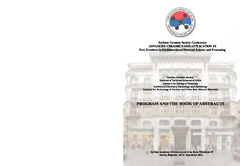Приказ основних података о документу
Synthesis and characterization of ZnO nano/micro crystals with enhanced sunlight-induced photo-catalytic activity
| dc.creator | Stanković, Ana | |
| dc.creator | Veselinović, Ljiljana | |
| dc.creator | Škapin, Srečo Davor | |
| dc.creator | Marković, Smilja | |
| dc.date.accessioned | 2021-10-11T11:59:13Z | |
| dc.date.available | 2021-10-11T11:59:13Z | |
| dc.date.issued | 2021 | |
| dc.identifier.isbn | 978-86-915627-8-6 | |
| dc.identifier.uri | https://dais.sanu.ac.rs/123456789/11911 | |
| dc.description.abstract | It is known that the functional properties of zinc oxide (ZnO) materials depend on their physico-chemical properties, such as optical properties and specific surface area. They are defined with structural characteristics, for example: the particle size and morphology, phase composition, crystallite size, crystallinity degree, as well as the crystal structure ordering, i.e., the presence of structural defects. The primary purpose of this study was to synthesize ZnO powders with various physico-chemical properties by optimizing the reaction conditions in different processing methods. For example, reaction temperature or addition of various surfactants such as polyvinyl alcohol, polyvinyl pyrrolidone, or polyethylene oxide. In this study, to vary physico-chemical properties of ZnO particles, four different synthesis methods were employed: mechanochemical, hydrothermal, ultrasonic and microwave processing. Structural and morphological properties of prepared ZnO powders were characterized using a number of techniques such as: X-ray powder diffraction (XRPD), Raman and Fourier transform infrared (FTIR) spectroscopy, field emission scanning electron microscopy (FESEM), UV-Vis diffuse reflectance and photoluminescence (PL) spectroscopy. One of the functional properties of the synthesized ZnO powders that was particularly examined is photocatalytic activity. In order to examine ZnO as a photocatalyst, photodegradation of methylene blue (MB) dye was carried out under simulated and direct sunlight irradiation. The UV–Vis spectra showed that the modification of the particle size and morphology from nanospheres to micro-rods resulted in increased absorption, and a slight red-shift of the absorption edge. Besides, the band gap energy of the synthesized ZnO micro and nanocrystals showed the red shift compared to bulk ZnO. According to the results of a Raman spectroscopy, the enhanced visible light absorption of the ZnO micro and nanocrystals is related to two phenomena: the existence of lattice defects (oxygen vacancies and zinc interstitials), and the particle surface sensitization by different surfactants. | sr |
| dc.language.iso | en | sr |
| dc.publisher | Belgrade : Serbian Ceramic Society | sr |
| dc.relation | info:eu-repo/grantAgreement/MESTD/inst-2020/200175/RS// | sr |
| dc.rights | openAccess | sr |
| dc.rights.uri | https://creativecommons.org/licenses/by/4.0/ | |
| dc.source | Program and the Book of abstracts / Serbian Ceramic Society Conference Advanced Ceramics and Application IX : New Frontiers in Multifunctional Material Science and Processing, Serbia, Belgrade, 20-21. September 2021 | sr |
| dc.subject | zinc oxide | sr |
| dc.subject | ZnO | sr |
| dc.subject | photo-catalytic activity | sr |
| dc.subject | photodegradation | sr |
| dc.subject | methylene blue | sr |
| dc.subject | X-ray powder diffraction | sr |
| dc.subject | XRPD | sr |
| dc.subject | Raman spectroscopy | sr |
| dc.subject | Fourier transform infrared spectroscopy | sr |
| dc.subject | FTIR | sr |
| dc.subject | field emission scanning electron microscopy | sr |
| dc.subject | FESEM | sr |
| dc.subject | UV-Vis diffuse reflectance spectroscopy | sr |
| dc.subject | Photoluminescence spectroscopy | sr |
| dc.title | Synthesis and characterization of ZnO nano/micro crystals with enhanced sunlight-induced photo-catalytic activity | sr |
| dc.type | conferenceObject | sr |
| dc.rights.license | BY | sr |
| dcterms.abstract | Марковић, Смиља; Веселиновић, Љиљана; Шкапин, Сречо Давор; Станковић, Aна; | |
| dc.citation.spage | 36 | |
| dc.citation.epage | 36 | |
| dc.type.version | publishedVersion | sr |
| dc.identifier.fulltext | https://dais.sanu.ac.rs/bitstream/id/47418/Stankovic_ACA-IX-2021.pdf | |
| dc.identifier.rcub | https://hdl.handle.net/21.15107/rcub_dais_11911 |

